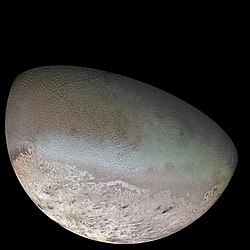Wikijunior:Solar System/Neptune/Triton

Triton is the largest moon of the planet Neptune, and the seventh largest in the Solar System. The best view we have had of Triton was in 1989 when the Voyager 2 spacecraft passed close by Neptune.
How big is Triton?
[edit | edit source]Triton has an average size of 2700 km across, which is larger than Pluto and about the same size as Europa. The moon is about half the width of the United States.
What is its surface like?
[edit | edit source]
The surface is icy and the temperature on the surface is bitterly cold. The southern half of the planet is covered by an ice cap. The moon does have a very thin atmosphere.
Triton is one of the few places in the Solar System where there are volcanoes. These are caused by the distant heat from the Sun. The volcanoes spew material from below the surface, mostly very cold dust and gas. These geysers are slowly reforming the surface, and have wiped out any craters.
How long is a day on Triton?
[edit | edit source]One day on Triton lasts for 5.877 days on Earth, around 5 days and 21 hours.
How long is its orbit around Neptune?
[edit | edit source]Triton takes 5.877 days to complete an orbit around Neptune, the same time as the length of one day. This means it always keeps the same side facing toward Neptune.
This moon is unusual because of the direction of its orbit around Neptune. Normally a moon orbits in the same direction that the main planet rotates. However Triton has a retrograde orbit, which means it orbits in the opposite direction. It is the only large moon in the Solar System to have a retrograde orbit.
Because of this backward orbit, Triton is gradually being dragged closer and closer to Neptune. Millions of years from now it will come too close to the giant planet and break apart. When it does so, the debris will form a large ring around Neptune that is similar to the ring around Saturn.
What is it made of?
[edit | edit source]This moon is mostly made of rocky material with about a quarter made of ice. It is very similar to Pluto temperature wise, but it is more of an icy texture and composition.
How much would Triton's gravity pull on me?
[edit | edit source]If you were on Triton, it would pull you down with a force less than one-twelfth as strong as the force of Earth's gravity.
Who is it named after?
[edit | edit source]Triton was the son of Poseidon in Greek mythology. In Roman Mythology, Poseidon was called Neptune.
How was it discovered?
[edit | edit source]Triton was discovered by William Lassell in 1846, shortly after the planet Neptune was discovered. However the moon was named by Camille Flammarion in 1880. The name of this moon did not come into general use until the middle of the twentieth century.
